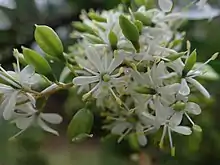Bursaria
Bursaria is a genus of eight species of flowering plants in the family Pittosporaceae and is endemic to Australia. They are shrubs or slender trees, often with spiny branches and have simple leaves, relatively small flowers with five sepals, five petals and five stamens, and fruit that is a flattened, thin-walled capsule.
| Bursaria | |
|---|---|
 | |
| Bursaria spinosa | |
| Scientific classification | |
| Kingdom: | Plantae |
| Clade: | Tracheophytes |
| Clade: | Angiosperms |
| Clade: | Eudicots |
| Clade: | Asterids |
| Order: | Apiales |
| Family: | Pittosporaceae |
| Genus: | Bursaria Cav.[1] |
| Species | |
|
See text | |
Description
Plants in the genus Bursaria range from low shrubs to small, slender trees and have branches that are often spiny. The leaves are arranged alternately along the branches or clustered and are linear to lance-shaped, egg-shaped or wedge-shaped, sometimes with toothed edges or a notched tip. The flowers are relatively small, arranged singly in racemes or panicles at the ends of branchlets or in leaf axils. There are five sepals that are free from each other, five narrow oblong, spreading white petals, and five stamens that are free from each other. The fruit is a flattened, thin-walled capsule containing ten to fifty kidney-shaped seeds.[2][3][4][5]
Taxonomy
The genus Bursaria was first formally described in 1797 by Antonio Cavanilles in his book Icones et descriptiones plantarum and the first species he described was Bursaria spinosa.[6][7] The genus name, Bursaria means "possessing a bag or a satchel".[8]
Species list
The names of eight species are accepted by the Australian Plant Census as of October 2021:[9]
- Bursaria calcicola L.Cayzer, Crisp & I.Telford (N.S.W.)
- Bursaria cayzerae I.Telford & L.M.Copel. (N.S.W.)
- Bursaria incana Lindl. (N.T., Qld.)
- Bursaria longisepala Domin (N.S.W.)
- Bursaria occidentalis E.M.Benn. (W.A.)
- Bursaria reevesii L.Cayzer, Crisp & I.Telford (Qld.)
- Bursaria spinosa Cav. – sweet bursaria, blackthorn (S.A., Qld., N.S.W., Vic., Tas.)
- Bursaria tenuifolia F.M.Bailey (Qld.)
Distribution
Species of Bursaria occur in all Australian states and territories and the Northern Territory.[9]
References
- "Bursaria". Australian Plant Census. Retrieved 31 October 2021.
- "Bursaria". Royal Botanic Gardens Victoria. Retrieved 31 October 2021.
- "Bursaria". Royal Botanic Garden Sydney. Retrieved 31 October 2021.
- "Bursaria". FloraBase. Western Australian Government Department of Biodiversity, Conservation and Attractions.
- "Bursaria". State Herbarium of South Australia. Retrieved 31 October 2021.
- "Bursaria". APNI. Retrieved 31 October 2021.
- Cavanilles, Antonio Jose (1797). Icones et Descriptiones Plantarum. Vol. 4. Madrid. pp. 25–26. Retrieved 31 October 2021.
- Sharr, Francis Aubi; George, Alex (2019). Western Australian Plant Names and Their Meanings (3rd ed.). Kardinya, WA: Four Gables Press. p. 65. ISBN 9780958034180.
- "Bursaria". Australian Plant Census. Retrieved 31 October 2021.
External links
 Media related to Bursaria at Wikimedia Commons
Media related to Bursaria at Wikimedia Commons